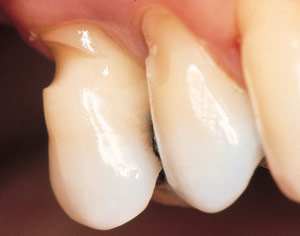

MedFriendly®


Abfraction
Abfraction means to break away but the term is often
used in dentistry as a mechanism to explain the cause
of non-carious cervical lesions (NCCL). NCCL is the
abnormal loss of dental structure at the cemantoenamel
junction (CEJ) and which is not caused by bacteria.
The CEJ (known informally as the neck of the tooth) is
a structural border on the tooth where the enamel and
cementum meets. Enamel is the covering of the
surface (crown) of the tooth whereas cementum is the
covering of the root of the tooth.
FEATURED BOOK: The Excruciating History of
The indentations on the top of
these teeth are abfractions.
The theory behind abfraction is that the abnormal loss of dental structure is caused by
the teeth flexing under pressure. This is thought to cause tension on one side of the
tooth and compression on the other side, separating the structural rods that are the
basis of tooth enamel, leading to V-shaped indentations on the tense side and C-shaped
indentations on the compressed side.
Not all dentists believe in abfraction as the cause of NCCL. Such dentists believe that
excessive tooth brushing is the cause. Toothpaste has been shown to be abrasive
enough to cause the same damage seen in NCCL combined with the person brushes too
hard and fast.
"Where Medical Information is Easy to Understand"™
















